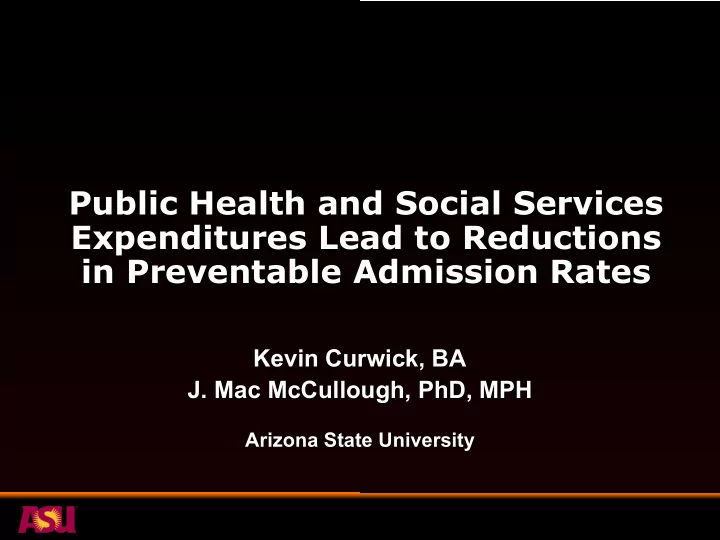

Public Health and Social Services Expenditures Lead to Reductions in Preventable Admission Rates Kevin Curwick, BA J. Mac McCullough, PhD, MPH Arizona State University
Financial Disclosures • The authors do not have any financial relationships to disclose.
Background • Focus on the contribution that “social services” have on health outcomes • Social services contribute to individuals’ ability to access health-supportive services Source: McGinnis JM, Williams-Russo P, Knichman JR. The case for more active policy attention to health promotion. Health Aff (Millwood) 2002, 21(2):78-93.
Background • Previously established links between spending and health outcomes – Premature death – Overall mortality rate – Disease-specific death rates • Limits of current research: ? ? ? $$$
Research Objective • To identify the influence of local public health and social services spending on avoidable hospitalizations.
Theoretical Model and Hypothesis • Hypothesis: Increases in local governmental spending for public and other relevant social services would result in better social services (quality or quantity) available to the community, reducing the need for ambulatory care (quantity or quality) and avoidable hospitalizations. SDoH Ambulatory care need $$$ Unnecessary hospitalization
Methods: Data Sources County Public Spending 2007 – 2009 data for all 80,000+ local governments on social services* Avoidable Hospitalizations 2011 – 2013 data for 1,264 counties County Socioeconomic Data Measures hospitalizations for a composite of 12 Median household income, unemployment, conditions for which access to high quality uninsurance, population size and demographics, etc. primary care could have avoided (e.g., uncontrolled diabetes or HTN, asthma, dehydration, etc.) Hospital Community Health Service Provision 2012 data on number of community health services (community outreach, education initiatives, health fairs, etc.) offered by hospitals in each county *Available as Census every 5 years, we obtained a special-use version with annual estimates for 80%+ of the population. We used linear nearest neighbor interpolation for individual missing estimates.
Types of Spending Examined Social Services Education – Fire & Ambulance – K-12 education Services – Higher education – Housing & Community Development – Libraries Health – Natural Resources – Public Hospitals – Parks & Recreation – Public Health and – Protective Inspections Community Healthcare – Public Welfare – Sewerage – Transportation – Waste Management
Methods: Analytic Models • Simplified Model Structure: PQI (year 5) = Change from Baseline Spending for: Health, Social Services, and Education (year 1) + County Sociodemographic Factors (year 5) + Health Factors (year 2) + Baseline Spending for Health, Social Services, & Edu • xtmixed regression using Stata 15 – County and year fixed effects – State random effects
Results • 32 states reported Spending PQI data (50 states reported spending) • Counties (n = 1,264) spend an average of $508 on health, $910 Average PQI Fifth Qunitile on social services, Fourth Quintile Third Quintile Second Quintile First Quintile and $1,975 on education PQI • Yellow = more/healthier • Red = less/sicker *Above charts use a 2011- 2013 average for visual representation
Results After controlling for baseline spending: $10 per capita increase from average spending amount ( 5 years ) 1.8 – 2.2 preventable hospitalizations avoided per 100,000 population
Discussion • Additional spending for social services associated with reductions in preventable hospitalizations – Even after controlling for other spending, community resources, baseline health factors, and other county characteristics • Hospitalizations for acute conditions seem to be more sensitive to spending within a 5-year period • More social service spending is associated with a reduced need for ambulatory care (quantity or quality) and avoidable hospitalizations, which is a leading indicator for overall health outcomes of a community.
Thank you! Questions? kcurwick@asu.edu
Recommend
More recommend